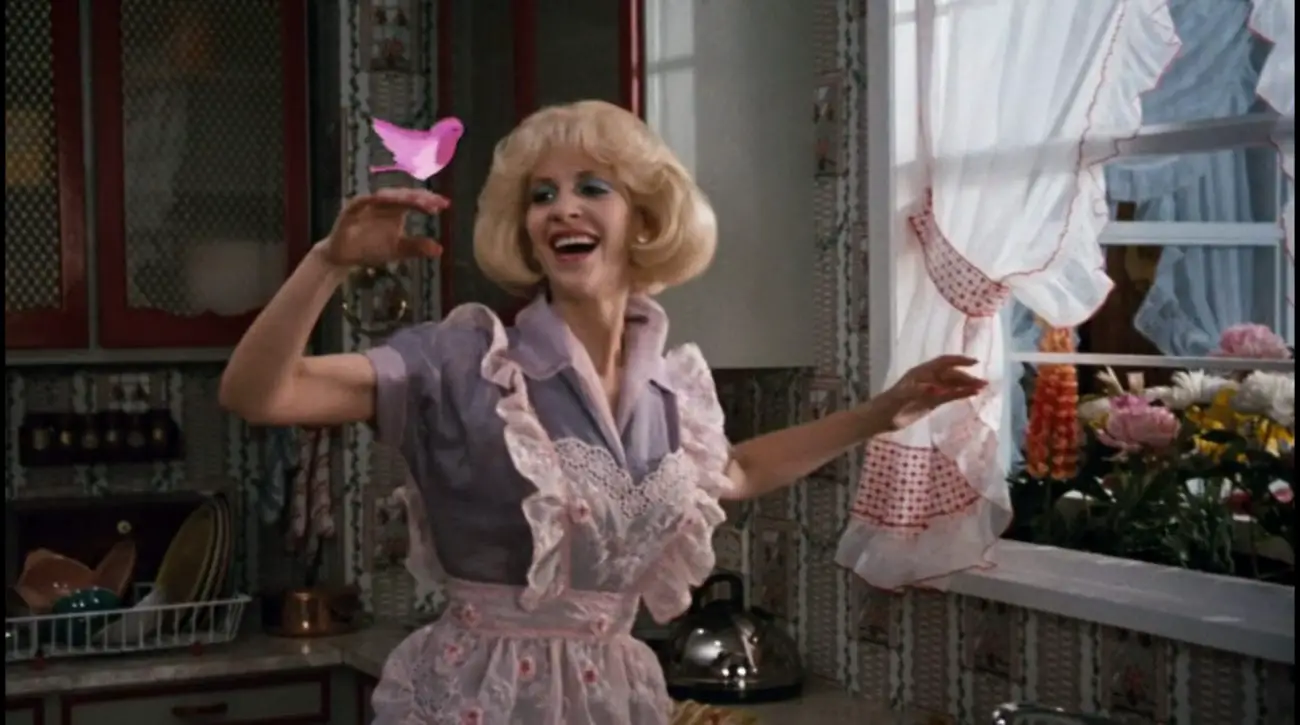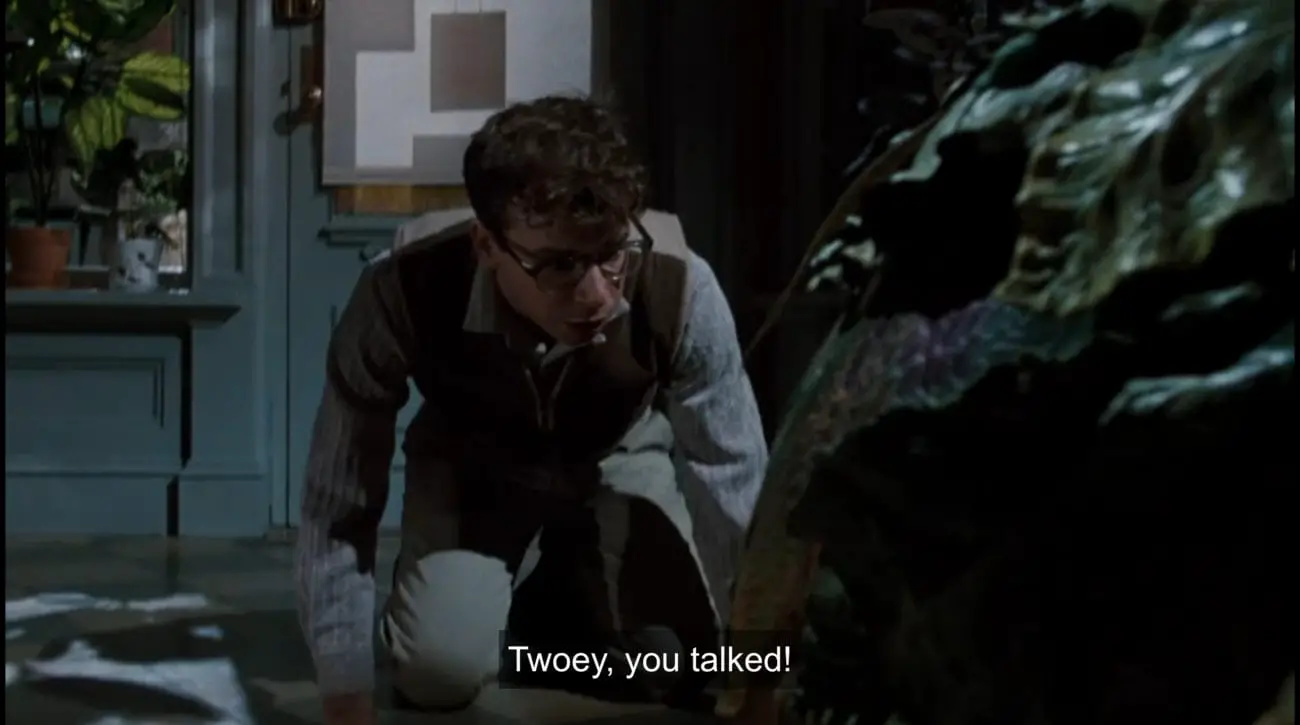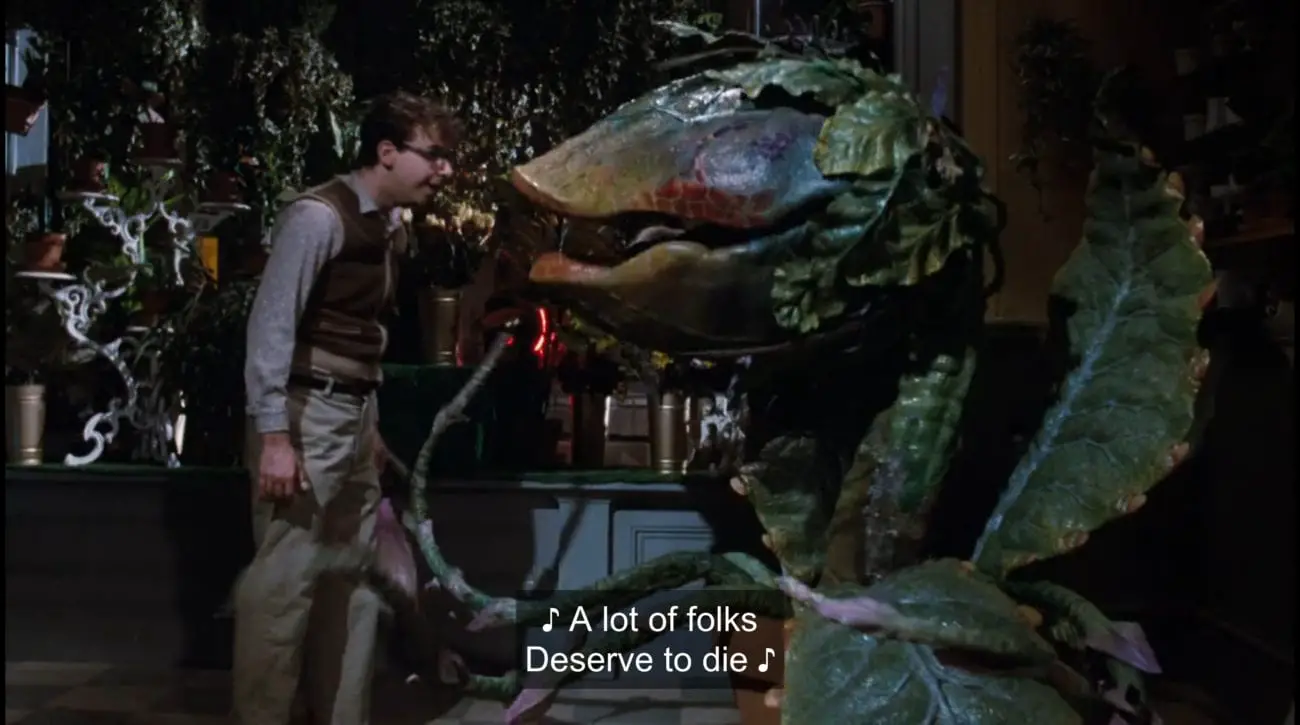Little Shop of Horrors Plant Drawing
Here we have another example of the "horror-comedy musical" genre: an occurrence as rare and special as a total eclipse of the sun. Little Shop of Horrors began as a black-and-white 1960 film (entitled The Little Shop of Horrors) directed by Roger Corman. Corman never copyrighted the film; thus, it is widely available to watch and/or download for free, including at the Internet Archive. The film was adapted into a stage musical (which dropped the "The" from the title), which premiered Off-off-Broadway in 1982, moving to Off-Broadway a couple of months later. The musical was then adapted into a 1986 film, which, in fact, has two different endings. The first ending filmed, which can now be seen in the "Director's Cut" of the film, follows the ending of the stage musical. The second ending was created after the first ending bombed with test audiences for various reasons and became the theatrical ending. Each ending is worth a watch, and you can choose from there how you'd rather have Seymour (Rick Moranis), Audrey (Ellen Greene, who originated the role in the stage musical), and everyone else's stories end.
The differences between the two diametrically opposed endings and how they serve the story are worth an analysis all their own. For now, we're going to weed our way through the tangled vines of this tale and examine how its roots of both comedy and horror blossomed into a film adaptation beloved by so many. (All puns intended, of course.)
The Comedy
Being a film with a hefty dose of comedy, the comedy in Little Shop of Horrors comes from many sources. Some of it is straightforward slapstick, like Seymour standing in a puddle or radio DJ Wink Wilkinson's (John Candy) on-air antics that would sound funny enough in audio alone, but are even funnier when we get to actually see what goes into creating them. Some of it's subtle, like Audrey's sling for her broken arm that must be so ludicrously ineffective or a motorcycle stopping because a dentist who's an Elvis wannabe looked at it. Some of it is plays-on-words and other verbal humor, such as the local radio station being WSKID (as in "Skid Row") or Seymour's exasperated tempting of fate.

These are jokes and gags that would fit into any comedy or musical comedy, whether a murderous bass-singing plant was involved or not.
The exaggerated characters and their mismatched reactions to their circumstances, such as overreactions and under-reactions in situations that call for the opposite, also add comedy.
The characters are a collection of exaggerations. Audrey has her breathy voice that can transform into a powerful belt at any moment, along with her perfectly-coiffed hair. She dreams of a better life "far from Skid Row," filled with amazing things like…plastic-covered furniture, a twelve-inch black-and-white TV, and a toaster.

Seymour's so meek that he goes along with pretty much anything, even as he gets swept up in increasingly wild circumstances and personalities looking to capitalize on his strange and interesting plant.

Even Mr. Mushnik (Vincent Gardenia), who's sometimes even more grounded than Seymour, can oscillate between extreme excitement and extreme frustration with the only slightest of triggers. The side characters, such as Orin Scrivello, DDS (Steve Martin), and even bit characters, such as "The First Customer" (Christopher Guest) and Arthur Denton (Bill Murray), are equally as wacky and memorable as the main characters, creating an entire world where everyone is the most exaggerated versions of themselves.
But…with this crazy crew of ridiculous characters, where can horror even find room to plant its seeds?
The Horror
The horror stems from Audrey II (pun intended). It's a plant that craves human blood, and eventually humans, that grows dramatically in size and strength whenever its appetite is satiated…which is never for very long.
As Audrey II grows, so does its appetite and abilities. It talks—heck, it sings! It can move of its own accord. Eventually, it can even move its pot from its place in the corner. All the while, its appetite grows from a drop or two of blood every so often to constant hunger for entire humans. Of course, Audrey II would've shriveled up and died at Chang's without Seymour; however, the Seymour we see in the film almost certainly wouldn't have ever shed anyone's blood, including his own, without Audrey II nudging him down that path.
The animal kingdom already has dangerous carnivores that can be used in horror films and immediately stimulate an apprehensive response in audiences: sharks, big cats, bears, carnivorous dinosaurs, and more are obvious signs of danger. But plants? The list of carnivorous plants is exceedingly small, they almost exclusively stick to a menu of insects and other bugs, and the trapping of their prey is out of a physical reaction to the prey landing on them, not out of the plant reaching out and grabbing or chomping its victims. But a carnivorous plant, even one that eats insects that fall into its nature-made trap, is so removed from most people's typical experiences with plants that it stands out and sparks the imagination. If a plant can devour insects, what's to stop a new strand of plant from popping from the ground that can grow larger and crave larger meals?
Without Audrey II, Little Shop of Horrors is just a little shop; of comedy, of fun characters, and of catchy music, sure, but with no horror to speak of (except the sadistic, abusive dentist never getting his comeuppance).

But if this murderous, manipulative, carnivorous plant has been dropped into a world where it clearly doesn't fit, how can the two sides of the story truly blend?
How They Mix
By blending stage staples with the medium of film, Little Shop of Horrors blends horror and comedy. A fascinating aspect of Little Shop of Horrors is how it takes elements from the stage version that many filmmakers would strike out of hand when adapting it. There are many differences between the medium of film and the medium of live theater, and yet, there is more potential crossover than some may believe. Within the story itself, the aforementioned exaggerated characters and their reactions that don't always match the circumstances or what we've come to expect from them blend the two genres further.

In live theater, because it's happening live and in person right in front of the audience, there's much less of a perceived divide between the audience and the actors. An actor looking at the audience isn't a surprise, particularly in a musical. An actor directly addressing, running through, or interacting with the audience can be surprising to audience members, but is far from rare. In theater, audiences feel like they're "in the room" as the events unfold, whether you're eavesdropping or an active participant.
In film, on the other hand, the audience is more akin to people watching through a window. Due to the medium itself, audience participation is much more difficult to pull off. Even with advances in technology, by now, people are so used to the separation of the screen that acknowledging the audience in any way, much less inviting them to actively participate, is still a surprise.
One of the most obvious examples of this in Little Shop of Horrors is the team of Crystal (Tichina Arnold), Ronette (Michelle Weeks), and Chiffon (Tisha Campbell) serving as a "Greek chorus" in the film. A "Greek chorus" is so named because it began as a theatrical tradition in ancient Greece: a group of actors not involved in the story unfolding who would tell the audience about the play, whether through spoken lines, song, or dance. The Greek chorus' various functions included commenting on the themes being presented in the play and passing judgment on the characters for making moral or immoral decisions.
This is where Crystal, Ronette, and Chiffon stride in sync onto the screen in matching, vibrant outfits, belting and riffing an energetic and "I dare you not to groove along" song directly to the audience. This opening number establishes the entire tone and world of the film. The lyrics warn that something ominous lurks on the horizon. The song's style shows that it's going to be a fun and entertaining ride. Skid Row's buildings and people are mostly decked in drab shades of brown or gray, and here comes this trio in bright blue, somehow shielded from the pouring rain and dancing right through that fourth wall, solidifying them as mostly separate from the story.

The few times they are actually involved in the story, their hair's less coiffed and their clothes change to blend with Skid Row's drab setting, a clear signal of their shifting status. Though Crystal, Ronette, and Chiffon are the most obvious example of involving the audience, there are many other instances of townspeople and other characters, such as Orin, looking at or otherwise directly addressing the audience.
Speaking of the other characters, their reactions that are at odds with the circumstances at hand—whether overreactions, under-reactions, or whatever in the world "The First Customer" was doing—blend horror and comedy further. For a rapid-fire series of examples, just look at the scene when Seymour first puts Audrey II in the window.
While walking past Chang's, Seymour swings his arms a little too high for someone who's supposedly casually strolling down the street. The doo-wop singers aren't too much of a surprise, but Seymour trying to join in is. Then, there's a surprise "total eclipse of the sun" (which everyone looks directly at, for some reason), followed by a strange noise and a strange plant appearing seemingly out of nowhere. Seymour's somewhat surprised, but casually buys it for $1.95.
So many scenes, sequences, and simple dialogue exchanges or facial expressions show these mismatched reactions that to list and analyze them all would be to summarize almost the entire film.

Even ignoring that this is coming from a mysterious singing plant (which is only slightly more alarming than having it come from a mysterious singing barber), hearing this sort of sentiment stated (or sung) so plainly is shocking. And for a person as kind-hearted and sensitive as Seymour, it's surely horrifying and, combined with his meekness, surely makes for an agonizing moral dilemma.

…Or it's like correcting a toddler who called someone "stupid" and he'll mostly be over his inner conflict in a couple of minutes.
The mash-up of a murderous, manipulative, carnivorous plant literally dropped into a comedy would've worked on its own as a fun ride. This is where the musical genre adds its own spice to the mix of plant food.
On the surface, it would seem that adding such a genre would rip the film even further from reality. And yet, watching the film, the characters aren't so far from reality that the audience feels completely removed from them, their problems, and their hopes and dreams. This empathy for and connection with the characters comes from the musical numbers, notably, "Skid Row." Songs in musicals are often used to show a character's innermost thoughts and feelings. As choreographer Bob Fosse said, "When words aren't enough, sing. When singing isn't enough, dance." Feeling stuck and trapped, desperately wanting to get out of that trap, but not seeing any way out despite all your best efforts, is a feeling so many people experience, and it's certainly a feeling for which subtle facial expressions or thoughts spoken in voiceover isn't nearly enough.
The songs draw us further in, rather than push us out. They add to the fun, but they also add depth to the characters. These characters are exaggerated on the surface, but once we know their inner lives, we know people who are like them, and maybe even relate to them ourselves. Orin's comeuppance doesn't feel like a tragedy, just like it wouldn't have in a horror-comedy, but it's not because he's a crazy character we don't care about either way who gets his comeuppance in a comical way: it's because he's abusive toward Audrey, whom we do care about…and gets his comeuppance in a comical way.
Essentially, the horror, comedy, and musical elements of Little Shop of Horrors are blended so thoroughly that this is what makes the film blossom. Remove any element of it, and a key nutrient is gone, making the film dry up and shrivel into a husk of itself. Remove the horror, and you have a musical comedy whose plot would most likely revolve around an abusive boyfriend portrayed extremely comically…yikes. Remove the comedy, and you have a dramatic horror musical about a killer plant, which still has the potential to become a cult classic, but because of unintentional comedy, not the actual merits of the film. Remove the music, and it's a horror-comedy that's fun enough, but risks being a surface-level parody without engaging characters or story on its own, separate from what it's spoofing.
If you haven't seen Little Shop of Horrors, it's definitely worth a watch, and both endings are worth a watch. If you like horror, you'll enjoy seeing the genre played with in a loving way; if you don't like horror, you won't find it scary. If you like comedy, you'll gobble this up Audrey II-style. If you like musicals, you'll be grooving around the room; if you don't like musicals, the film is crazy and ridiculous enough to warrant the addition of music…and you'll be grooving around the room.
And for anyone who rolls their eyes at musicals because they aren't "realistic"…show me a mean, green, carnivorous plant from outer space who doesn't sing.
aguileraponnowelin.blogspot.com
Source: https://horrorobsessive.com/2020/11/25/little-shop-of-horrors-that-strange-and-interesting-plant/
0 Response to "Little Shop of Horrors Plant Drawing"
Post a Comment